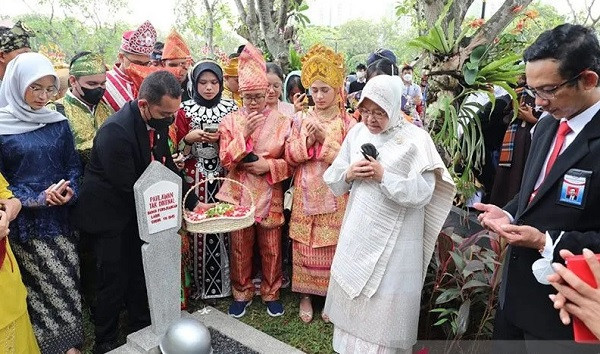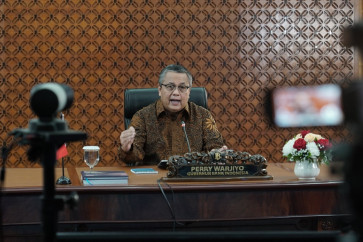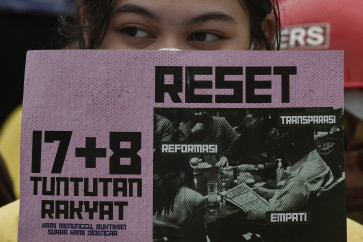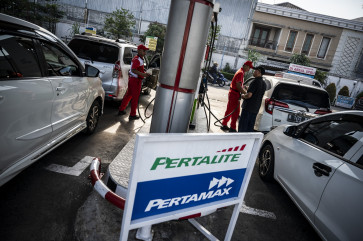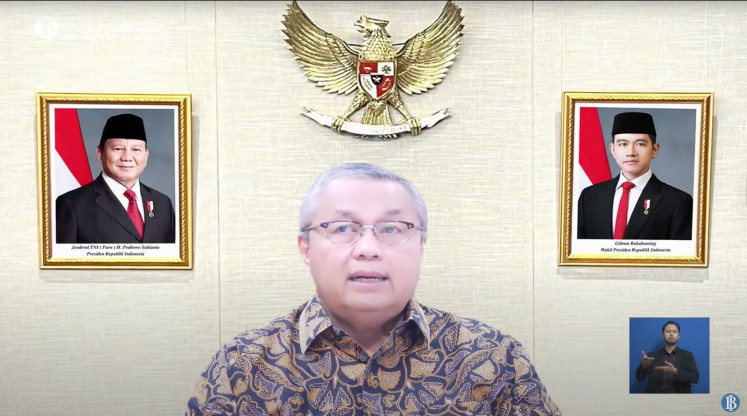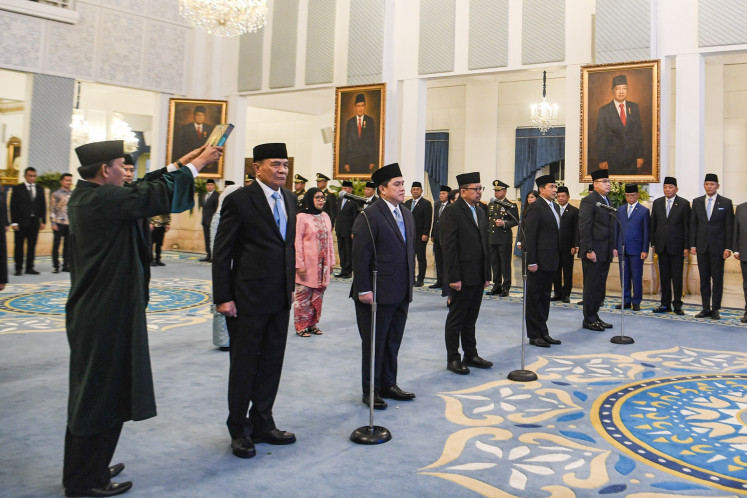Popular Reads
Top Results
Can't find what you're looking for?
View all search resultsPopular Reads
Top Results
Can't find what you're looking for?
View all search resultsWomen heroes are now the currency of the world!
The fact that the gallery of heroes in Indonesia is so male-dominated is shocking, but hardly surprising, given how patriarchal Indonesian society has been, and still is.
Change text size
Gift Premium Articles
to Anyone
“Money makes the world go round,” they say. But so do heroes, as well as women of course.
So why are there so few images of women on bank notes? The Indonesian rupiah has denominations of 100,000, 50,000, 20,000, 10,000, 5,000, 2,000 and 1,000, and all but one are graced with images of male heroes. The only woman to make it onto an Indonesian banknote, and it is on the smallest denomination, the 1000 rupiah, worthless, except as small change, is Tjut Meutia (1870-1910). She was a brave and exceptional Acehnese woman who fought against the Dutch colonial rulers, and was declared a national hero on May 2, 1964.
Every year, since 1959, we celebrate Heroes Day on Nov. 10. I came across three articles on that day, written by women. Two were about the dearth of female heroes, one was about how people “become” heroes. The latter was by Bivitri Susanti, an expert on constitutional law.
Bivitri’s article, “Heroes and Civic Space” (Kompas, Nov. 10), points out that invariably a “hero” is decided upon by those in power, which is why it is usually the government that awards the hero title, usually picked from and by the members of the elite.
In reality, real heroes are not a government product, in fact, they are often invisible and unrecognized. How many of us have our own personal heroes, who unselfishly served or helped us in one critical instance, or continuously throughout our lives?
“Heroes are people who propagate the idea of independence at a time when talking about independence is prohibited”. The red thread, Bivitri points out, heroes fight to defend each other, in order to practice their civic role in a civic space.
The two other pieces were by Ika Ariyani, author at konde.co, an online publication focusing on women and minority rights, and Anugerah Adriansyah, a Voice of America (VOA) journalist. They wrote that there are 185 men, but only 15 women heroes (8 percent) in Indonesia. For Ika, this is proof that women are ignored in history, and that the criteria of identifying heroes is very masculine.
Ika wrote that it is as if men are the only people who are considered meritorious and contributing to society. The notion of a hero should be broader and more inclusive, and not limited merely to armed battle or politics. They should include “the struggle to eliminate discrimination and violence against women and the fulfillment of their basic rights such as the right to education, the abolition of child marriage, the right to self-development, work and career, the right to participate in politics and leadership, and the right to organize, from historical times until now”.
In 2021, the National Commission on Violence against Women (Komnas Perempuan) introduced six women from different sectors and regions: Lasminingrat (literacy and independence movement, from Sunda/West Java); Mona Laturina (warlord against Dutch colonials, from Maluku); Boetet Satidjah (founder and editor of Perempuan Bergerak, from North Sumatra; Seiati Surasto (1965 generation, defense of women workers); Auw Tjoei Lan (prevention and saving women and children victims of human trafficking, ethnic Chinese); and Tamu Rambu Margaretha (anti-slavery activist, from Sumba). In 2022, Komnas Perempuan added three more.
As Veryanto Sitohang, a Komnas Perempuan commissioner pointed out, the geographical diversity and cultural richness embody much local history that contain stories of the struggles of female figures. "Resilience comes from the wisdom of women in life, which often acts as a catalyst, or even an innovating force, creating a new culture that is more just and equal", Veryanto added.
At times there are cases of a husband and wife who fought together but it is only the husband who got hero status. This was the case with Ki Hajar Dewantara (1889-1959), an independence movement activist, politician and pioneer of education for native Indonesians in Dutch colonial times. He was declared a national hero by president Sukarno in 1959, while his wife, Raden Ajeng Sutartinah (1890-1971), who struggled just as hard, hand-in-hand with her husband, virtually disappeared into historical oblivion.
For me, Inggit Garnasih, Sukarno’s second wife, sorely needs to be declared a hero. They married in 1923, divorced in 1942, and in those 19 years, she supported his studies, as well as his struggle for independence. Reading the story of their marriage, I believe that Sukarno would not have made it without her support and unflinching love and devotion to her husband, who was 15 years her junior. Would Indonesia then not have gained independence? Maybe it still would have, but perhaps not with Sukarno as its leader.
The fact that the gallery of heroes in Indonesia is so male-dominated is shocking, but hardly surprising, given how patriarchal Indonesian society has become, and still is. It is not for nothing that it is called his-tory, not her-story, and demands from feminists for a more gender-equal and inclusive history of Indonesia have been growing louder in these recent years.
Why is this? History can be a blueprint for the present and the future. This is why JJ Rizal, historian, founded Komunitas Bambu, a publishing house focusing on books which present an alternative history, on May 20, 1998, at the onset of the Reform era. He said the authoritarian New Order regime was based on historical lies, distortion and manipulation. It stuck to its version of history for 32 years, as without it, it would have lost its legitimacy.
There are those who still insist on the New Order version of the 1965-66 tragedy, even the government, despite the fact that so much historical evidence has demonstrated that their version of events was totally fabricated.
This is also the case with history, which is based almost wholly on a male perspective. It results in a patriarchal authoritarianism that is hard to dislodge. This is how gender inequality prevails, which now makes it the greatest injustice of the 21st century, as colonialism and racism were in the past, and even then, both still exist in new forms.
Recently I had a chat with Fahmi Wibawa, the newly inaugurated, dynamic and innovative executive director of the Institute for Research, Education and Information on Economy and Social Affairs (LP3ES) about my plans for the gender center of LP3ES that I lead. Among other plans are to produce historical books with a gender perspective, including a history of the women’s movement, as well as a history of Indonesia from a feminist perspective.
He asked, “You speak of the past, what about the present?” The two are related and of course, I plan to develop gender awareness and empowerment programs both externally and internally. After 50 years of not having any women in decision-making positions, or a gender perspective, LP3ES needs to start working on it, so that it can walk the talk. A debunking of HIS-tory is crucial to pave the way for the present and the future.
Anne Hathaway, renowned Hollywood actress and United Nations Women goodwill ambassador recently spoke at the Group of 20 Summit in Bali. She called upon the business community to act so that women can be put at the heart of economic growth. This is also true in general of societal progress. Currently, there exists a gender apartheid that needs to be abolished. South Africa has done away with apartheid, how come Indonesia and the world has not?
When we have done that, perhaps we will have more images of women heroes on Indonesian bank notes which would signify a change in currency in more ways than one.
***
The writer is the director of the Gender and Social Inclusion Center, Institute for Research, Education and Information on Economy and Social Affairs (LP3ES).

